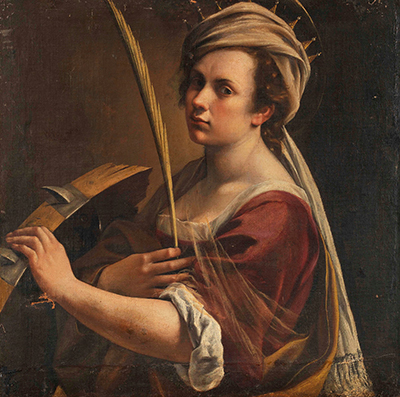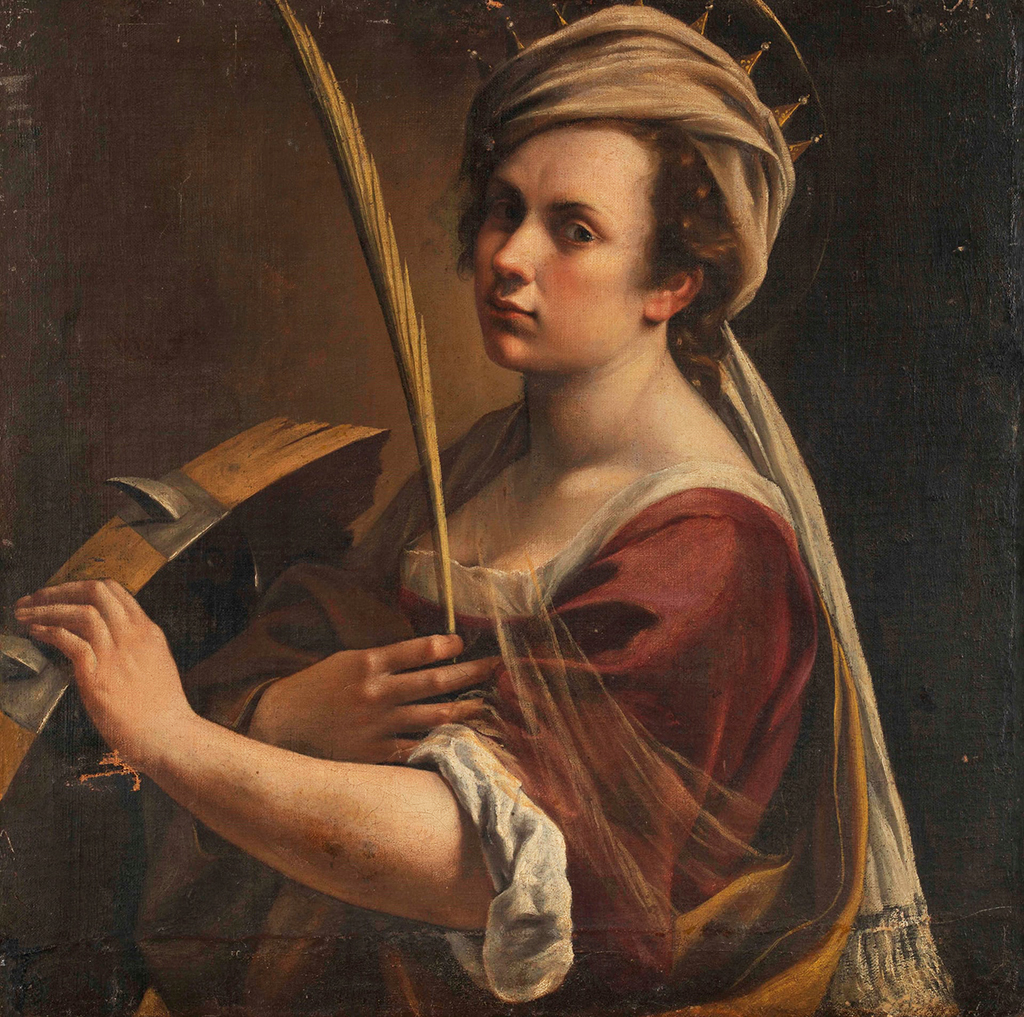Artemisia Gentileschi was a 17th century Italian Baroque painter born in Rome on July 8, 1593. During her time women were less recognized in the artistic world and she acts as an inspiration for her predecessors by being the first woman in history to make a living by painting.
A woman's life during the time was a tough one and she worked mostly on the scenes of heroic females especially the warriors and those who were victims of the patriarchal society. Using her dramatic style, her work can be found in several prestigious museums in the world. She worked on her piece Self-portrait as Saint Catherine of Alexandria in 1615-1617 after her famous rape trial in 1612, where she undergone so much torture including her fingers being crushed as a way of verifying that she was telling the truth. Saint Catherine of Alexandria was a Christian saint who was martyred and tortured in the 4th century by the Emperor Maxentius who condemned her to death on a spiked wheel. She leans on the broken wheel with iron spikes with her hand holding the instrument of torture and a palm on the other close to her chest.
This art indeed portrays the suffering that the artist faced at the age of 17 during this trial. Agostino Tassi, who worked with her father Orazio Gentileschi, raped her after he was hired to be her tutor. After the trial she was married of to Pierantonio Stiattesi from Florence. The art has the following dimensions: 71.5cm by 71cm (28.1 in by 28 in) using oil on canvas medium and it is located in the national gallery of London. She moved to Florence after her trial where she made this self-portrait. She developed quickly after moving, both artistically and also in terms of her own character and confidence. She would refer to the awful sexual assault that she experienced years earlier within several paintings that made use of various feminine icons and looked to visually promote the strength of women as a collective against the oppressive nature of men within society at that time.
Introduced to painting by her father she was more determined than her brothers, who together they helped at their father's workshop. Just like her father her style was inspired by Caravaggio but her style was more realistic and natural compared to her father's which was more idealized. She gained so much success in Florence being the first woman to be accepted into the academy of arts, "Accademia delle Arti Del Disegno". She returned to Rome in 1621 but her work was not appreciated as she expected. Later she joined her father in London when he became a court painter at the court of Charles I of England where they worked together in so many pieces. She later died gracefully in 1656. Artemisia Gentileschi would establish herself as the most important female member of the Baroque art movement and laid the groundwork for many other women to follow on in future centuries, with a variety of other styles leading all the way up to the present day where things can be said to have become somewhat fairer across genders.
This painting was fairly recently (2018) purchased by the National Gallery in London, UK for an impressive fee of £3.6 million. The fund for this was put together by a number of charitable organisations which seek to protect the UK's cultural display. The institution was understandably delighted with the purchase and immediately set about constructing an impressive exhibition on the artist's career in which it would be unveiled to the public. A number of her artworks were loaned in from elsewhere for the period of several months and an insightful publication was also released in conjunction with this event. The National Gallery focuses on pre-19th century art, in the main, and there are not many women who have achieved prominence across the period of European art that it covers, making the acquisition of a Gentileschi painting particularly important. The arrival of this artwork at an institution such as this has also allowed scientific researchers the opportunity to investigate the piece in great detail, where normally those in private collections are not really accessible in such a way.
The previous owner of this painting must have made a considerable profit having purchased the painting for around €2.4m in late 2017. Although that price was much higher than the original guide price, the seller believed that it could be sold on for a profit elsewhere. Even with the fees due at any auction, the later sale the following year represents a successful piece of business, though that individual remains unknown. To put things into context, it was the first purchase of a painting by a female artist for the National Gallery since as far back as 1991, which reflects the distinct lack of available artworks for these more traditional periods of European art. For example, if it had instead focused on more contemporary art, then there would have been many more potential opportunities over the past few decades, such as with the likes of Kahlo, O'Keeffe, Cassatt or Morisot, to name just four. There is not an awful lot that can be done about this, other than seeking to delve deeper into the work of Baroque and Renaissance female artists, and attempt to
The National Gallery continues to offer one of the most impressive selections of art anywhere in the world, and benefits from the strength of the British Empire in previous centuries. Today there are a number of charitable bodies which help to add to the collection on an annual basis, as well as attempting to learn new things about the paintings that they already own. The opportunity to see most of their collection entirely for free is one of the great advantages of visiting public galleries within the UK, which attempts to allow as many people as possible to learn about art and history, whilst also encouraging an increase in tourism from abroad. Typically, the major exhibitions are paid-for events, costing close to £20 in most cases, but the extensive permanent collection is enough to keep you occupied for many hours and that remains on offer free of charge. Additionally, artists have flocked to this gallery for decades, seeking to learn more from the great masters in order to improve their own technical ability.
Some of her other most famous paintings include the following:
- Susanna and the Elders
- The Virgin Nursing the Child
- St Cecilia Playing a Lute





